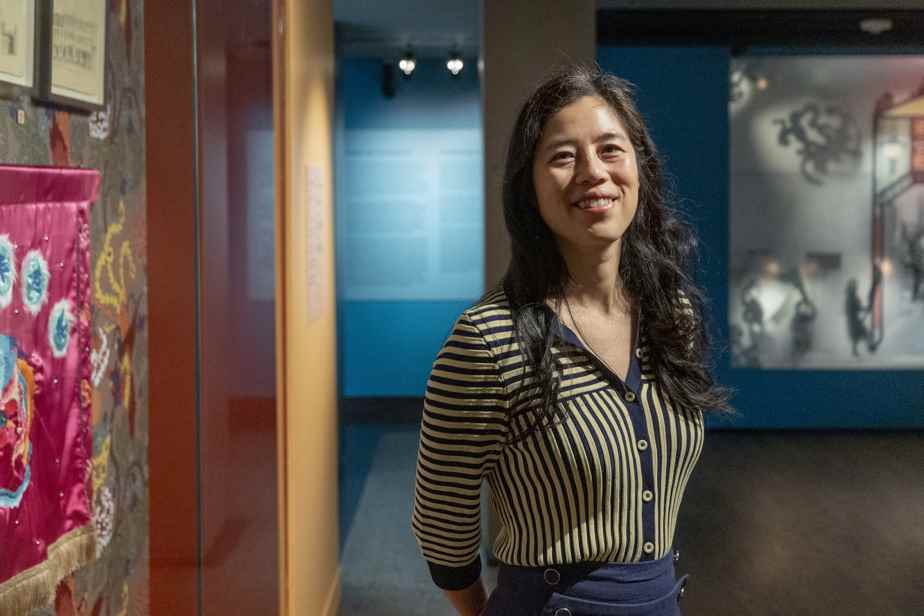At the end of an artistic residency of several months at the McCord Stewart Museum, the artist Karen Tam exhibits the results of her research which focused on the Chinese community of Montreal, of which she is a part. The exhibition swallow the mountains is also a salute to the resilience of Canadians of Chinese origin who often had to swallow snakes in their adopted country.
In these times of diplomatic tensions between Canada and China, an exhibition that addresses the living conditions of Quebecers of Chinese origin is a good opportunity to reflect on our history, which is strewn with generous acts, but also with attitudes condemnable to their regard. With swallow the mountainsKaren Tam, born in Montreal in 1977 to Chinese parents, looks at the history of Chinese migration to Canada since the 19e century. These citizens came to settle in the “Golden Mountains”, as they had nicknamed the country of the gold rush.

PHOTO PROVIDED BY THE MUSEUM
Group photographed for Sun Tobefore 1923, William Notman & Son, McCord Stewart Museum Collection
A harsh law
But the Golden Mountains had dull sides. Racism, but also isolation, since Canada has long prevented, by a heavy head tax, Chinese immigrants from allowing their wives to join them. This year marks the 100e anniversary of the adoption of the Chinese immigration law, which prohibited all Chinese immigration to Canada, unless one was very wealthy. It was not until Canadians of Chinese origin fell in combat during the Second World War that Canada repealed this law, which remained in force for years to come.

PHOTO WILLIAM NOTMAN, PROVIDED BY THE MUSEUM
Governesses and the McDonald ChildMontreal, 1867, William Notman, collection of the McCord Stewart Museum
Karen Tam delved into the archives of the McCord Stewart Museum last June to discuss the difficult living conditions of Montrealers of Chinese origin, especially women. She also collected documents from members of the Chinese-Montreal community. The result is an exhibition with all sorts of objects, clothes, furniture, photographs and a film summarizing his approach. An exhibition in which we discover the characteristics of this population long concentrated in Chinatown, but today melted into the Quebec community, even if there are new concentrations, as in Brossard.

PHOTO PROVIDED BY THE MUSEUM
Flowerpot1900-1925, Bretby Art Pottery, McCord Stewart Museum Collection
The photographs provided by the Chinese community make us realize that the immigrants who arrived in Quebec have integrated by adopting our activities. Do winter sports, play baseball, participate in festival activities (dragon boat!), go to the beaches, etc. A photo from the 1940s shows about twenty engineers of Chinese origin established in Montreal.

PHOTO MARCO CAMPANOZZI, THE PRESS
A window of the exhibition contains in particular Chinese objects sold in old shops in Montreal.
Revealing niches
Karen Tam has created several niches in which she discusses particular topics. In one of them, she represented twice the Chinese character meaning happiness, a symbol exhibited at weddings. In another niche, we see his two great-grandparents. The man was one of the Chinese who came to “make a fortune” in Canada. The two portraits are accompanied by empty armchairs suggesting the suffering of these men deprived of their wives because of the law of 1923. In a window, Karen Tam exposes the certificate of identity issued by Ottawa in 1912 to her great-grandfather .
-

PHOTO MARCO CAMPANOZZI, THE PRESS
The double Chinese character meaning twice happiness
-

PHOTO MARCO CAMPANOZZI, THE PRESS
Karen Tam’s great-grandparents
-

PHOTO MARCO CAMPANOZZI, THE PRESS
Examples of Identity Certificates for Chinese Immigrants in the 1920s
1/3
A wall diffuses Chinese shadows of characters from a Cantonese opera from which we hear an excerpt. The decor consists of a photo taken in Chinatown, this block that remains after massive reductions in its area from the 1960s to the 1980s, to allow the emergence of the head office of Hydro-Québec, the Complexe Desjardins, the Complexe Guy-Favreau and the Palais des Congrès. Karen Tam is working on the idea of a Cantonese opera that will take place in these places of often bitter memory, the Chinese community believing that they have been hurt in the past by a certain disdain from the municipal administration.

PHOTO MARCO CAMPANOZZI, THE PRESS
On the right, the sound work The journey of a heroine through hostile territories
On another wall, Karen Tam has created a large showcase with, in the background, a magnificent wallpaper with Chinese motifs. On display are silk evening coats worn by Montreal women in the 1910s, a wooden and filament fan created by the artist, and photographs of members of the community, including Edith Eaton, a Montreal writer born to a British father. and a Chinese mother who signed her works Sui Sin Far.

PHOTO PROVIDED BY THE MUSEUM
Silk evening coatcirca 1906, McCord Stewart Museum Collection
The profusion of images of Chinese Montrealers, with family, at school, playing hockey, paying homage to ancestors, participating in community meetings, in shows, make us endearing these fellow citizens that we meet in the Quartier. Chinese. This is undoubtedly the success of this exhibition, but also of the tireless artistic work of Karen Tam for 20 years: allowing us to make a distinction between international politics and the richness of our diversity.
